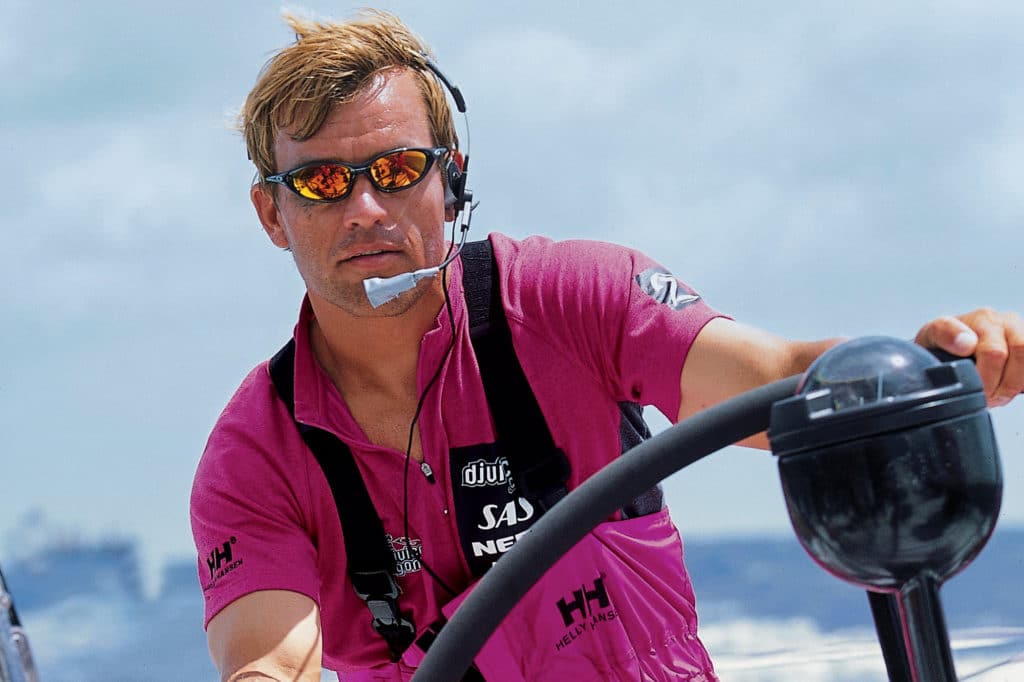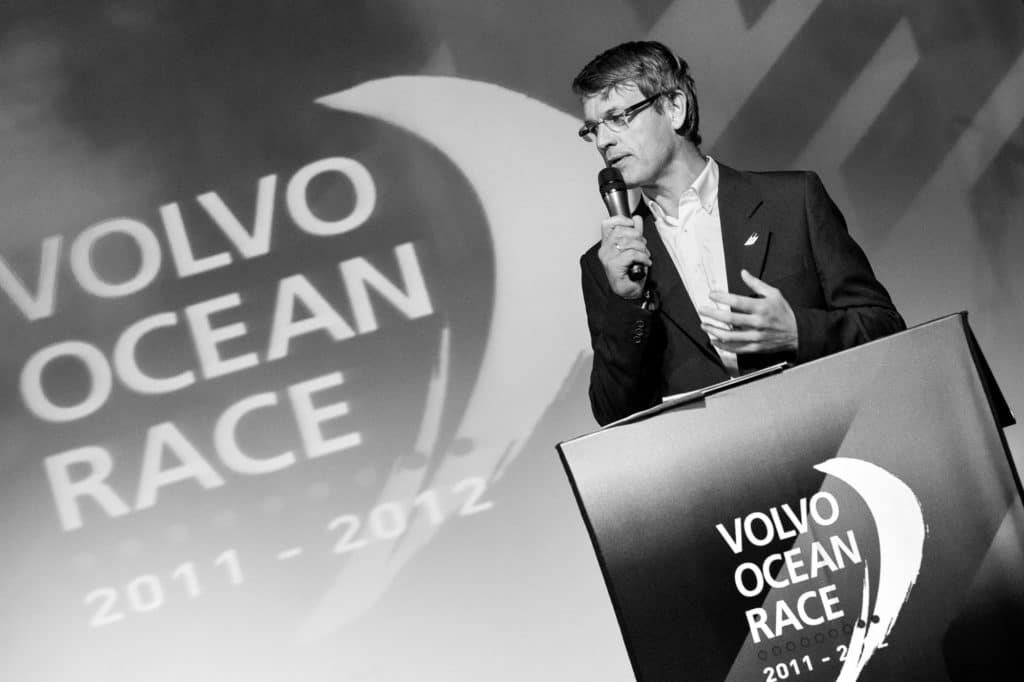
Knut Frostad, as skipper of Innovation Kvaerner, was topping the overall leaderboard in the 1997-98 Whitbread Round the World Race. He had just finished leg two, which stretched 4,600 nautical miles from Cape Town, South Africa, to Fremantle, Australia.
Several days earlier, Innovation Kvaerner had slipped into second place for the leg—a position that didn’t please Frostad or navigator Marcel van Triest. In an effort to reclaim the lead, they aggressively hunted a massive low-pressure system deep into the Southern Ocean. They found wind but suffered collateral damage: two broken steering wheels, shattered mainsail battens and other broken bits.
Night fell. Frostad found himself steering with 40-plus knots of wind howling through the rigging. Water was everywhere. He couldn’t see his instruments, so he had a crewmember call out the numbers as he surfed the vessel down huge seas at 30-plus knots.
“It was important to get to the bottom of a wave at the right wind angle to avoid gybing,” Frostad recalls. “I had to keep the boat between 120 degrees and 130 degrees. My crewmate started screaming when I got too low.”
While harrowing, the experience taught Frostad that he could trust his B&G instruments to help keep his crew safe. It was a lesson that would serve him well during his decorated sailing career and in his new role as Navico’s CEO.
The saying goes that experience is the best teacher and a driver of innovation, and Frostad has offshore miles and leadership lessons to spare. These include three and a half circumnavigations during the Whitbread and the Volvo Ocean Race, numerous Atlantic crossings, and an extended cruise with his family aboard their former Outremer 5X catamaran. All up, Frostad has cruised more than 280,000 nautical miles.
Then, there was his work as CEO for three editions of the Volvo Ocean Race. When he started there, media engagement was a borderline afterthought; by the time he left, he had helped to revolutionize the race’s storytelling capabilities vis-a-vis drones, onboard reporters and satellite communications. Additionally, Frostad served on the board of directors for Navico—parent company of B&G, C-Map, Lowrance and Simrad—for 14 years before signing on as CEO in June 2019.
Eight months later, Frostad, Navico and the entire world sailed into the unforeseeable hurricane called the COVID-19 pandemic.
“It brought me right back to my Volvo Ocean Race days,” Frostad says. “As a Volvo Ocean Race skipper, you only know that something will [eventually] go really wrong … so you practice crisis situations. When something happens, you activate the crisis plan. We did this at Navico, and we got the company through in a healthy way, although it’s far from over yet.”

While fallback positions are important, Frostad is quick to acknowledge that the best sailors remain calm in rowdy weather. “We almost enjoy it,” he says. “That attitude has been really helpful during the pandemic.”
Another important tool that Frostad acquired during his racing days is the ability to read people and have empathy for their challenges. “You can’t close your office door,” he says, adding that aboard offshore-racing sailboats, “everyone will know everything about you.”
Even today, he values people and embraces a transparent leadership style. For example, Frostad freely admits that he knew relatively little about manufacturing practices before taking over Navico’s reins, so he put himself on a steep learning curve. “How well you manufacture has a massive impact,” he says of a company’s bottom line, adding that—just as in sailing—how well a team works together makes a huge difference. “An [offshore-sailing] team needs to get a little faster every day. It’s a relentless pursuit of improvement.”
While Frostad was accustomed to managing a global organization, taking over as Navico’s CEO created different challenges. “We have over 2,000 people in over 40 sites in 24 countries,” he says. In a way, the pandemic provided cohesion. “It was one thing we all had to rally around,” he says.
Frostad is a self-described tech geek who clearly understood—and trusted—B&G’s sailing-specific electronics prior to accepting the job. However, he admits to another knowledge gap when it comes to the power-cruising and fishing markets.
“One thing that you can’t learn early enough are your customers’ real needs,” he says. “Fishing is a new world to me. The mentality of wanting to know every detail of the seafloor—I’m blown away by it. I can relate with wind shifts in sailing, but you need to experience it to understand it.”
Which is precisely what he did in the months preceding the pandemic. “The big thing to learn was sonar and transducers,” he says. “I’ve spent a lot of time studying this technology, and I’m still learning.”
Looking ahead, Frostad points to artificial intelligence and how it could be leveraged to enhance boating. “It’s easy to go crazy with technology, so we have to stay true to the basics, like safety,” he says. “Marine electronics need to work when you leave the dock, so we test products and make them 100 percent reliable. It’s why we work with the Volvo Ocean Race or many of the best professionals.”
This, of course, is the same methodical approach that enabled B&G to build the wind-sensing electronics that kept Frostad and his Innovation Kvaerner crew alive in the Southern Ocean that windswept night.
He knows, as a boater himself, that recreational boating is a passion more than anything else. “No one needs it—they do it because they love it,” Frostad says. “They might only use their boat for one or two months a year, but it’s their highlight. I get to work at a company where we make [their experiences] better. It’s a gift.”









